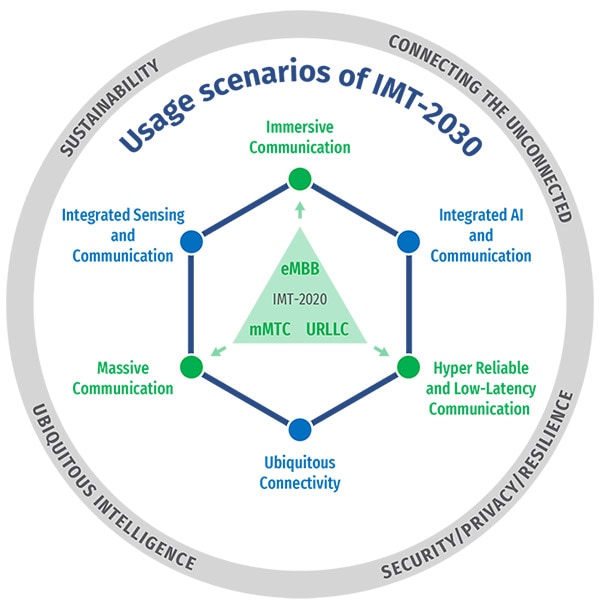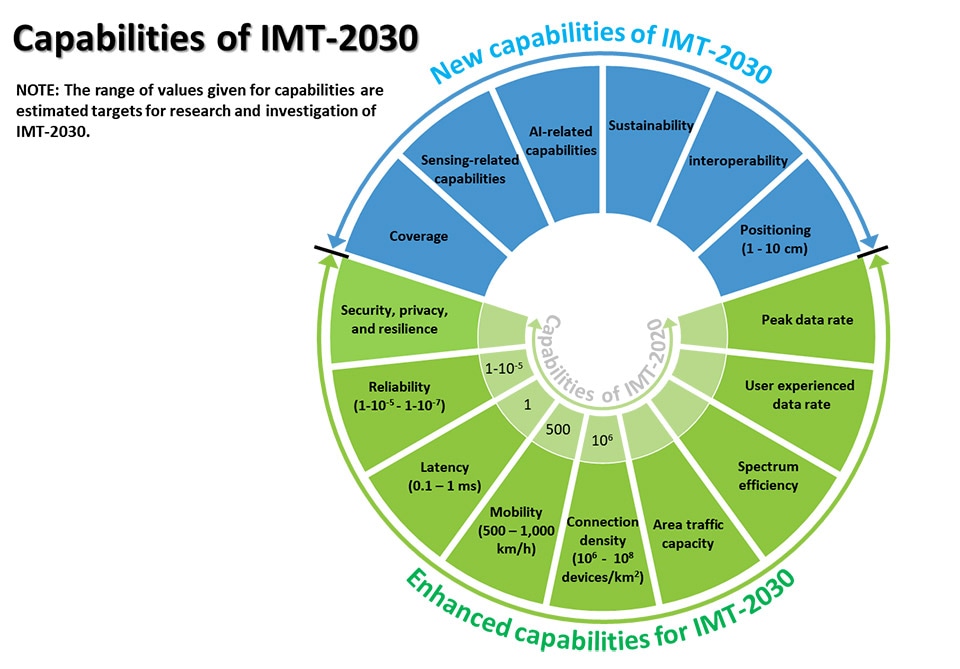IMT Vision – Framework and overall objectives of the future development of IMT for 2030 and beyond
This ITU-R recommendation in progress will be the main focus of next week’s ITU-R WP5D meeting #43 in Geneva. It defines the framework and overall objectives for the development of International Mobile Telecommunications (IMT) for 2030 and beyond. There are contributions related to this recommendation from: Apple, Nokia, Ericsson, Wireless World Research Forum, Motorola Mobility, Orange, United Kingdom of Great Britain and Northern Ireland, Finland, Germany, GSOA, China, Qualcomm, Electronics and Telecommunications Research Institute (ETRI), Brazil, Samsung, ZTE, Huawei, InterDigital, Intel and India, with several being multi-company contributions.
The objective is to reach a consensus on the global vision for IMT-2030 (aka 6G), including identifying the potential user application trends and emerging technology trends, defining enhanced and brand-new usage scenarios and corresponding capabilities, as well as understanding the new spectrum needs.
IMT will continue to better serve the needs of the networked society, for both developed and developing countries in the future and this Recommendation outlines how that will be accomplished. This Recommendation also intends to drive the industries and administrations for encouraging further development of IMT for 2030 and beyond.
The framework of the development of IMT for 2030 and beyond, including a broad variety of capabilities associated with envisaged usage scenarios, is described in detail in this Recommendation.
In June 2022, ITU-R decided on the overall timeline for 6G with three major stages:
- Stage 1 – vision definition to be completed in June 2023 before the World Radiocommunication Conference 2023 (WRC-23),
- Stage 2 – requirements and evaluation methodology to be completed in 2026, and
- Stage 3 – specifications to be completed in 2030. The 3-stage timeline and the tasks for each stage are summarized in Figure below.
This draft Recommendation defines a [potential] framework and overall objectives for the development of the terrestrial component of International Mobile Telecommunications (IMT) for 2030 and beyond. IMT will continue to better serve the needs of the [networked] society, for both developed and developing countries in the future and this [Recommendation/document] outlines how [possibly] that could be accomplished. This [Recommendation/document] also intends to encourage further development of IMT-2030. In this [Recommendation/document], the [potential] framework of the development of IMT-2030, including a broad variety of capabilities associated with [some possible] envisaged usage scenarios[, and those yet to be developed and] described in detail. Furthermore, this [Recommendation/document] addresses the objectives for the development of IMT-2030, which includes further enhancement and evolution of existing IMT and the development of IMT-2030.
It should be noted that this Recommendation is defined considering the development of IMT to date based on Recommendation ITU-R M.2083 (approved in September 2015).
Technology Trends:
Report ITU-R M.2516 provides a broad view of future technical aspects of terrestrial IMT systems considering the timeframe up to 2030 and beyond, characterized with respect to key emerging services, applications trends, and relevant driving factors. It comprises a toolbox of technological enablers for terrestrial IMT systems, including the evolution of IMT through advances in technology, and their deployment. In the following sections a brief overview of emerging technology trends, technologies to enhance the radio interface, and technologies to enhance the radio network are presented.
An important breakthrough in 3GPP Rel-17, Technical Specifications for Non-Terrestrial Networks (NTN) were established & defined for satellite direct access to device for both 5G and IoT services. This development reflects a trend that satellite & space technologies can offer many benefits for development & operation of future IMT-2030 networks, to enable 5G & 6G available everywhere, accessible to enterprises and citizens across the globe.
IMT-2030 will consider an AI-native new air interface that refers to the use of AI to enhance radio interface performance such as symbol detection/decoding, channel estimation etc. An AI-native radio network will enable automated and intelligent networking services such as intelligent data perception, supply of on-demand capability etc. Radio network to support AI services is the design of IMT technologies to serve various AI applications, and the proposed directions include on-demand uplink/sidelink-centric, deep edge and distributed machine learning. The integration of sensing and communication functions in future wireless systems will provide beyond-communication capabilities by utilizing wireless communication systems more effectively resulting in mutual benefit to both functions. Integrated sensing and communication (ISAC) systems will also enable innovative services and applications such as intelligent transportation, gesture and sign language recognition, automatic security, healthcare, air quality monitoring, and solutions with higher degree of accuracy. Combined with technologies such as AI, network cooperation and multi-nodes cooperative sensing, the ISAC system will lead to benefits in enhanced mutual performance, overall cost, size and power consumption of the whole system.
Computing services and data services are expected to become an integral component of the future IMT system. Emerging technology trends include processing data at the network edge close to the data source for real-time response, low data transport costs, energy efficiency and privacy protection, as well as scaling out device computing capability for advanced application computing workloads.
Device-to-device (D2D) wireless communication with extremely high throughput, ultra-accuracy positioning and low latency will be an important communication paradigm for the future IMT. Technologies such as THz technology, ultra-accuracy sidelink positioning and enhance terminal power reduction technology can be considered to satisfy requirements of new applications.
Energy efficiency and low power consumption comprises both the user device and the network’s perspectives. The promising technologies include energy harvesting, backscattering communications, on-demand access technologies, etc.
To achieve real-time communications with extremely low latency communications, two essential technology components are considered: accurate time and frequency information shared in the network and fine-grained and proactive just-in-time radio access.
There is a need to ensure security, privacy, and resilient solutions allowing for the legitimate exchange of sensitive information through network entities. Potential technologies to enhance trustworthiness include those for RAN privacy, such as distributed ledger technologies, differential privacy and federated learning, quantum technology with respect to the RAN and physical-layer security technologies.


UPDATE: https://techblog.comsoc.org/2023/07/09/draft-new-itu-r-recommendation-not-yet-approved-m-imt-framework-for-2030-and-beyond/
References:
Summary of ITU-R Workshop on “IMT for 2030 and beyond” (aka “6G”)
https://www.itu.int/en/ITU-R/study-groups/rsg5/rwp5d/Pages/wsp-imt-vision-2030-and-beyond.aspx
Excerpts of ITU-R preliminary draft new Report: FUTURE TECHNOLOGY TRENDS OF TERRESTRIAL IMT SYSTEMS TOWARDS 2030 AND BEYOND
Development of “IMT Vision for 2030 and beyond” from ITU-R WP 5D
ITU-R: Future Technology Trends for the evolution of IMT towards 2030 and beyond (including 6G)
China’s MIIT to prioritize 6G project, accelerate 5G and gigabit optical network deployments in 2023
ITU-R WP5D: Studies on technical feasibility of IMT in bands above 100 GHz
https://www.itu.int/rec/R-REC-M.2083 (Sept 2015)
2 thoughts on “IMT Vision – Framework and overall objectives of the future development of IMT for 2030 and beyond”
Comments are closed.




Also at ITU-R WP5D meeting #43 this week, ATIS will present two 3GPP contributions to revise ITU-R M.2150 “Detailed specifications of the terrestrial radio interfaces of International Mobile Telecommunications-2020 (IMT 2020)” which was formerly IMT 2020. The contributions contain stable 3GPP Release 16 specifications for additional 5G NR features and functionality.
The revision of M.2150 is expected to be completed at the June 2023 meeting #44 of WP5D.
Reference: https://www.itu.int/md/R15-IMT.2020-C-0058/en
Related reference:
https://techblog.comsoc.org/2023/02/07/itu-r-report-in-progress-capabilities-of-the-terrestrial-component-of-imt-2020-5g-for-multimedia-communications/